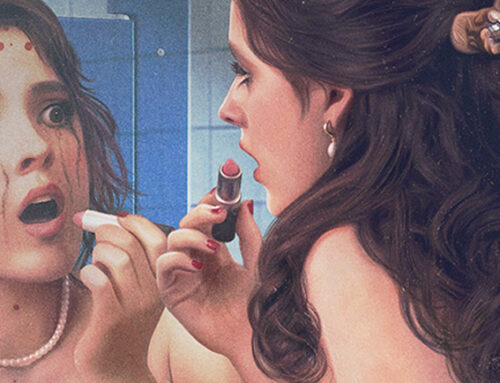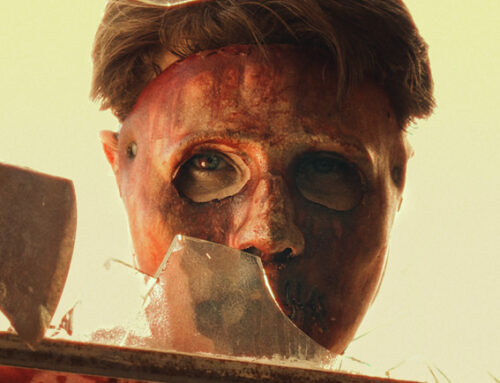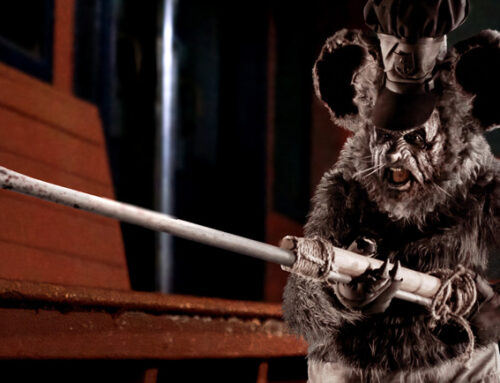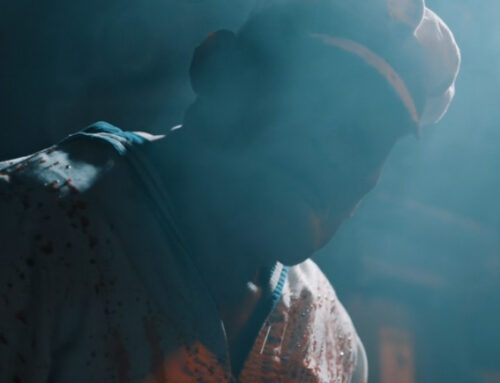A veteran war photographer with PTSD sees imminent deaths in his developed photos, questioning his already fragile sanity and putting the lives of those he loves in danger.
Camera Obscura, directed by Aaron B. Koontz , follows Jack Zeller (Christopher Denham) a former war photographer struggling to find work and maintain his floundering relationship with his fiancé Claire (Nadja Bobyleva) while facing the demons he brought back home. When we first encounter Jack, he’s recounting a recurring nightmare to his therapist, the scene of a boy standing over his mother’s lifeless, shrapnel-laden body burned into his mind to the point where he can no longer tolerate being a photographer and putting himself back in that mental space. Robbed of this driving force, his world falling apart, slipping between reality and his twisted internal nightmare, Jack is unable to engage with reality, and most importantly, his beleaguered yet supportive fiancé. In an effort to rekindle his passion, she buys him a vintage camera at an auction so that he can begin to rebuild the camera collection he put away when he left that life.
To be fair, the camera’s gorgeous, a 40s-era brown leather beauty featuring a curious undocumented feature – everything it shoots is in black-and-white – oh, and people that are about to die show up when the film is developed. On second thought, that may be the more concerning feature. Jack discovers this little kink when Claire asks him to shoot some real estate photos for the company she works for, a task that inexplicably takes him to a number of strange locations including a public pool, a commercial parking complex, and the dilapidated remains of what looks to have once been some sort of production facility, a contrivance that’s necessary for the events that follow, but one that never adequately accounted for. Claire is shown to be a typical real estate agent, showing homes to upper-middle class families, so it seems unlikely she would have any use for shots of an industrial facility that resembles the charred remains of a large-scale crystal meth lab, but they needed that set piece for later in the film, so we gotta get those shots. He takes the photos to a local shop to have them developed only to discover the aforementioned issues of the lack of color and unexpected corpses. Now, typically if you bring a roll of film filled with pictures of a bunch of dead folks, that’s going to raise some eyebrows with even the most hardened of dark room technicians (it’s clarified later that everyone else can indeed see the bodies in the pictures by Jack’s friend Walt (Noah Segan), who mistakes them for war scenes (which doesn’t make any sense if you think about it too long so don’t)), but he’s old friends with the manager, so they let it slide.
After getting the photos home and discovering their peculiarities, he lets out a mildly perturbed “what the fuck?” as if someone had smeared Cheeto dust over them and then, after a strange sequence of events that concludes with a surreal hallucination where a blood-soaked boy rises up from a pool and tears the flesh from his arms, he reasons through a few leaps in logic that only by replicating the exact location and method of death featured in the photos with another person in their place can the deaths pictured be averted, but sometimes the person that was supposed to die will end up replacing the person in the next photo, thus requiring the process to be done all over again, though this rule only seems to apply when it’s convenient. It’s an interesting if convolutedly justified concept that either needed to be better established or just left more loosely explained and up to interpretation. What we get is a sort of non-committal approach where the film isn’t quite sure whether it wants you to be on board with the logic or take it as a mentally-unstable man’s interpretation of reality. There’s a major plot line involving a previous owner documenting their experiences with the camera via a series of tapes, but not a lot of time is devoted to them and what we do get muddies the waters further by creating this notion of a sentient curse that seeks out vulnerable minds to do its bidding, a potentially fruitful concept that doesn’t end up being developed and finds itself lost in the noise.
What does end up working is the relationship between Jack and Claire. Their interactions are nuanced and natural, a credit to both the writing here and the strong performances delivered throughout. Denham does an excellent job of finding a balance between playing Jack as character filled with regret and pathos, while still showing glimmers of the charming, likable nerd below that gives his relationship credibility – he’s putting Claire through a lot, but you understand why they’re together and he doesn’t feel like a completely unhinged charity case. Bobyleva strikes a difficult balance of her own, managing to capture the anger and resignation of her character without having her come off as unnecessarily abrasive, her love for Jack coming through even in those most bitter moments. Unfortunately, they’re really the only characters we get outside of the victims (which I’ll get to shortly); his friend Walt, who is played competently and seems to care for Jack, but isn’t given much significance and doesn’t end up moving the plot forward or developing Jack’s character in any significant way other than to highlight how far he’s fallen from grace; and a couple of detectives he runs up against played by Catherine Curtin and Chase Williamson that end up going for a typical “good cop, bad cop” shtick while on the trail of this man who always seems to find himself at murder scenes.
I ended up watching this movie twice, because there really is a lot to take in between the storytelling and creative choices the film commits to and those that get left behind, but what ultimately didn’t hold up for me on the second viewing was Jack’s character, not so much his portrayal, but his motivations and what I am expected to feel for him. At times, he is presented as a sympathetic anti-hero, a flawed but fundamentally good-hearted person that is simply doing what he must to preserve the one person in the world he still seems to care about; at other times, he’s treated as a deranged, detached psychopath who commits heinous murders without a shred of regret. Most of the time they seem to be trying for the former, attempting to take the edge off his crimes by using a sort of dark comedy approach to demonizing his victims that seems both forced and manipulative. The absurd caricatures his victims create are used to almost justify their slayings, which are presented with brutal viscerality, by casting them as socially-awkward deviants and thus deserving of death. That’s not to say this isn’t a valid justification for Jack, many murderers have targeted people they believe to be deviant or low-class to justify their actions internally, but here that takes a more insidious bent as these preconceptions are used not only by Jack to convince himself, but also as a tactic to justify his actions to the audience. Again, I think it’s a matter of commitment. A darkly comic villainous approach to the character could have worked if those themes were better integrated, or he could have come off as much more sympathetic if more effort was put into emphasizing his regret and emotional peril over his actions, but without that focus I was left unsure how to feel about his character from scene to scene.
From a technical perspective, it falls into that class of competent yet unambitious indies with a handful of bold choices that typically don’t end up working all that well. The composition doesn’t usually try for anything too daring, with lots of empty medium shots with the occasional close-up used effectively to capture the sense of loss and hopelessness in Jack’s eyes. The desaturated, bordering on 70s grindhouse color grading doesn’t do the film any favors either; it’s not ugly, the visuals are crisp with sharp contrast, but the dull grays and browns don’t do anything to make the film more engaging to look at. There are some really artsy choices that don’t really mesh well with the rest of the aesthetic, the aforementioned bloodied pool boy scene taking on this bizarre palette that feels like a 90s music video as well as a blood-soaked sex scene that feels like something out of Excision but lacks the integration and cohesion that movie had with its surreal visuals. Much of the same can be said for the score, with many scenes being left completely unscored and most of the rest featuring a very sparse and subdued approach you could almost miss if you aren’t looking for it. When shit goes down though, the score ratchets up real quick in the mix, with very forceful, almost sirenlike heavy synths that feel like I’m playing Metal Gear Solid and I’ve just been caught by the guards. On the one hand, I can’t say this doesn’t add additional intensity to these scenes, but it also tends to upstage the action and choreography, which is largely well-executed, and gets to feel a bit tired throughout the film as the same theme is played for every intense scene with minimal variation.
Camera Obscura is Koontz’s first full-length feature as both writer and director, previously writing and directing a number of short films. It feels as though he is struggling somewhat here to adapt to the much larger space he has to fill and keeping these various elements running in a cohesive manner throughout, but in the end, they feel like growing pains that he will be able to overcome as he gets more comfortable with this new medium. The writing is sharp and there are ideas here that work, there just isn’t that development and commitment that needed to be there for the film to come together as a whole.
| Camera Obscura | ||
| RATING: | UR | Camera Obscura | Official Trailer [HD] | Chiller Films (2017) |
| Runtime: | 1hr. 35Mins. | |
| Directed By: | Aaron B. Koontz | |
| Written By: | Aaron B. Koontz Cameron Burns | |










